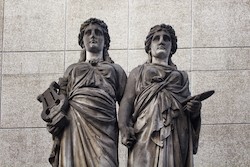Iron Age textiles give up their secrets to reveal patterns in human interaction
Fabric doesn’t hold up well over millennia, with a few notable exceptions garments are rarely discovered. But tiny fragments found alongside micro-organism killing metals can offer insight into population movements, trade and culture. The metal salts create casts of the fibers, preserving the microstructure for analysis and comparison. By the meticulous use of digital and scanning electron microscopy, high performance liquid chromatography and other advanced methods, the EU-funded PROCON project uncovered information on the nature of the structural features of the raw material, such as weave, thread thickness and thread count along with other parameters. The findings, and the conclusions drawn from them, are presented in a recently published paper, Tracing textile cultures of Italy and Greece in the early first millennium BC. Dr Margarita Gleba, the study's author and researcher at the McDonald Institute for Archaeological Research, University of Cambridge, states that there is overwhelming evidence for frequent contact between Italy and Greece during the first half of the first millennium BC, but that the textile traditions of each culture were very different. Her research indicates that the populations of the two regions made an active decision to clothe themselves in a certain way, perhaps in connection with traditions already established in the Bronze Age. This runs counter to our previously held assumption that Italy and Greece had similar technological and aesthetic traditions of textile production during the first millennium BC. What can ancient cloth tell us about the people who spun and wore it? Economic activities related to metal, ceramic and agricultural production and their relationship to urbanisation in Iron Age Italy and Greece has long been of interest to researchers. But the more ephemeral commodity of fabric and the light it shines on wealth generation and subsistence has not been investigated. The project considered the significance of the production and consumption of textiles in the development of city-states (as clothing, elite regalia, trade and exchange items). PROCON looked at warp, weft, thread diameter, thread twist direction, the type of weave or binding, thread count indicating cloth quality, the edges and the material of the fibers. The textiles reviewed, 192 for Italy, and 107 for Greece, came primarily from funerary contexts, with only a few fragments excavated in settlements, and a special group that was found frozen in the Italian Alps. This means their purpose was to clothe or wrap rather than, for example, use as sails or furnishing. The colour of the mineralised textiles is unknown, but dye analysis of some of the organically preserved finds indicates the use of sophisticated dyeing methods and a variety of plant dye sources, including muricid shellfish for purple, madder for red, woad for blue and a variety of yellow dyes. The paper explains textiles were probably decorated with various beads, buttons and appliqués in precious materials, such as bronze, gold, amber, glass and faience, found in their hundreds and even thousands in rich Iron Age tombs across Italy. Small domed bronze buttons are particularly common over a very wide geographic area. Analysis shows similarities in the Grecian samples with techniques of weaving used in the Near East rather than Central Europe, mirroring the close connections that existed between the areas. One textile form was found to have spread westwards early in the first millennium. In central Adriatic Italy, on the other hand, the predominance of another type of weave appears to agree with the generally accepted Adriatic- or Balkan-looking trends in the local material culture. PROCON (PROduction and CONsumption: Textile Economy and Urbanisation in Mediterranean Europe 1000-500 BCE) aims to investigate the role of textiles in the urbanisation and state formation of Mediterranean Europe (Greece, Italy, Spain) from 1000 to 500 BC and to demonstrate that textile production and consumption were a significant driving force of the economy and in the creation and perception of wealth. For more information, please see: CORDIS project web site
Countries
United Kingdom



